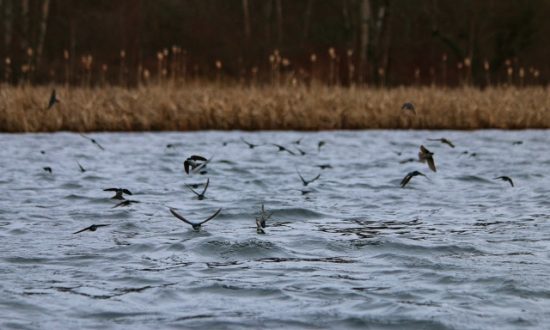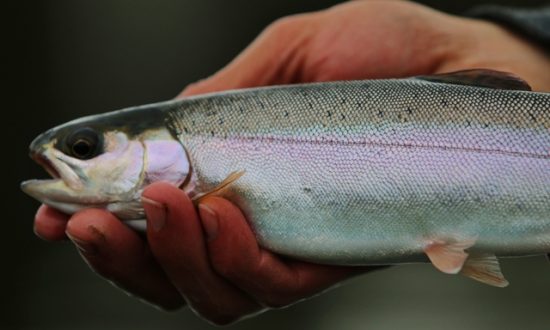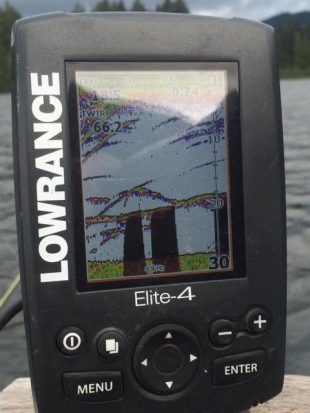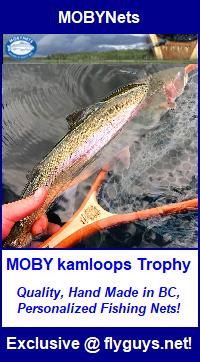Chironomid Fly Fishing Strategies
– Finding Fish –
Every spring, thousands of BC fly fishers head to their favourite lakes, eager to chase trout with chironomids of all shapes and sizes.The various techniques we use can yield incredibly exciting results. However, these techniques take time to hone and the early stages of the learning process can be very intimidating. Intuitively, fishing a very small fly very slowly at the end of a very long leader is a “needle in a haystack” approach. It just feels too random to work and many people quickly give up and return to fast trolling a big leech. Typically, what goes wrong is too much attention being given to the fly and not enough to its location. We all know that in order to catch fish the fly must be in the water – but where?
So, how do you find the fish when chironomid fishing?
Finding Fish | Other Anglers:
Your best resource for finding fish is the people who have already found fish. It’s really that simple. If one guy is catching lots of fish figure out what depth he’s fishing and focus your search on that depth. If you have the chance to go near the other person to take a donor fly that’s a great chance to gather some information. Use your fish finder to determine the depth in which he’s anchored and if you have any way of figuring out the depth of water he’s casting to get that as well. On one particularly tough day I remember offering to take a photo for a buddy just so I could figure out what he was doing without having to swallow my pride and ask. Assuming you haven’t annoyed the guys who are catching the fish by yelling and blasting your music all day, they probably won’t mind sharing some information. Pay close attention to the important details: depth of water, actual depth of fly, method of presentation and retrieve (which is closely related to actual depth of fly), fly profile, fly colour. In that order. The best fly in the world is useless if fish aren’t looking at it. The wrong fly in the right location will catch at least the occasional fish. The right fly in the wrong location will catch nothing.
Finding Fish | Hatches:
Find hatching bugs. A couple of Septembers ago a buddy and I were fishing a lake that was new to both of us. The lake has no useful visibility for anglers and has vast shoal areas as well as lots of deep water. In the absence of rising fish it feels completely hopeless. This time, though, there were a few nice-sized chironomids popping in extremely localized areas. Despite not seeing any fish rising I anchored right on top of the small number of emergers I was able to locate and started catching some fish. They were taking my vertical presentation within a couple of feet of bottom. I also had a naked line out (floating line with just a long leader and a fly), fishing the same depth, but it was probably spending most of its time 20-60 feet away from my boat and I only caught one fish on that set-up. The hatch was so localized that fish were feeding in little patches about 20 feet in radius. Within an hour that hatch was done and there were no fish around me. I moved a hundred feet or so until I found another little patch of bugs and, sure enough, began catching fish again in that spot. This worked for a couple of days and I needed to keep moving every hour as the hatch moved around in order to find fish. This all took place in 20 feet of water, which would otherwise have been a totally random depth.
Seriously, find hatching bugs even when the rules dictate that they shouldn’t be hatching! One of the other lakes my buddies and I know pretty well wasn’t particularly good to us the first couple of trips until we discovered chironomids popping in 30 feet of water about a hundred feet from the edge of the receding ice. There was a little strip of them emerging in that depth, parallel to the shore. We fished that unexpected hatch and did well. Meanwhile, any knowledgeable angler would have been fishing boobies in 6 feet of water because we all know that at ice off every fish in the lake is cruising in the top few feet of water. This method has worked every year since and there are always a few other anglers around who can’t (sometimes won’t) believe that we’re actually doing what we say we’re doing because it defies conventional wisdom. I actually had a guy get mad at me a couple of years ago and accused me of lying to him because he simply couldn’t believe I’d be fishing a chironomid almost 30 feet deep at ice-off.
Finding Fish | Rises & Moving Fish:
Investigate rises. Perhaps it’s obvious but it works. If things aren’t working out the way you’d like them to then find rising fish and target them. This doesn’t usually lead me to my biggest fish in chironomid season but pretty much always leads me to some fish and often a hatch. If nothing else, it can reveal a depth range that holds fish willing to move and eat. Get a reasonable fly in front of them and keep it there, acting natural, and you’re going to catch a few. At least you’ll have something to pump if you feel you need to.
Catching a couple of fish boost your confidence and gets your mind working in a way that allows you to start putting together the pieces of the puzzle. It’s amazing how quickly your state of mind can switch from an almost depressing feeling of low confidence to “I can do this”.
Finding Fish | Record Keeping:
Know your waters. If every trip is to a different lake you’re going to enjoy lots of nice scenery and might have some great days of fishing. You’ll never have a chance of doing as well as the guys who frequent those waters. Every lake holds secrets and the more time you spend in a location the more of those secrets reveal themselves to you, provided you’re paying attention. Part of really knowing your waters is keeping a log, journal, diary, or whatever you want to call it. I started doing this about 15 years ago and I have at least something written down from every single day I’ve fished since then. Last month, I did what I do every year as I sit around at work waiting for the first couple of trips – I read the whole thing. In doing so, the memories come flooding back to me and rather than start the year with twisted, fading memories I’ve got a pretty accurate picture of the things I’ve already learned. One big lesson for me was to stop chasing the ice around and start my season by fishing lakes that will be iced-off and tend to produce at that time. Some lakes just don’t produce for the first 3 weeks and others are rocking the minute there’s any fishable water. Some turn over as the ice recedes and others don’t turn over at all. Just because I like a particular lake doesn’t mean I would fish it at any old time of year. I know when the “right” times are and I focus on those. This also helps me decide when to try out new lakes. I can make a fairly good educated guess just based on what I know about other lakes in the area and what the satellite images show me in terms of water clarity, size, and approximate depths.
Finding Fish | Get Out of the Nursery:
Big fish often won’t associate with small fish. If you’re catching lots of fish and they aren’t as big as you think they should be, you might need to move. I’m not talking about full-blown kiddy pool action between the downed trees here. I’m talking about fish-a-cast 2 pounders when you know there are some 6s and 7s in the lake. They aren’t usually mixed in with the 2s. I think they find them annoying and if there are too many of the smaller ones the big ones just go elsewhere. You’ve got a couple of choices: either move, or wait for the mix of fish in your location to change. What often happens if you wait is that the hot action slows, followed by increasingly long periods when nobody is catching anything. The few fish that are caught at the tail end of the action are often a fair bit better than the ones caught earlier. Moving, on the other hand, can be really tough to persuade yourself to do but can pay dividends. Finding a few larger fish while they’re still in feeding mode is your best chance of getting a big one.
Finding Fish | Electronics (Fish Finders):
If you use electronics, learn them well. I’ve had my current Eagle FishMark 320 fish finder for at least 10 years. I think I spent the first 4 or 5 of those years thinking it was either broken or just cheap junk and I only relied on it for depth, bottom contours, and surface temperature. It either showed a blank screen or told all kinds of deceitful lies. I don’t know exactly when things changed but I must have played around with it enough that I suddenly started seeing fish that were actual fish. As Brian Chan says – turn off the fish symbols and learn to interpret the raw data. I also don’t run any alarms because I find all the sounds to be a needless distraction. I adjust the sensitivity for every lake and continue playing around with it until I know it isn’t giving me a bunch of false information. This does take some practice but once you build a relationship based on trust with your fish finder the returns will be great. Some lakes just don’t seem to agree with my finder and I might be down below 50% sensitivity while others allow for 100% with no false readings. Last spring was a really good one for me and the guys I fish with. There were lots of days where multiple people were getting over 30 fish between 9am and about 3pm. Pretty much all of it was in 26-32′ of water, fishing as close to bottom as possible. I spent most of that time with a vertical line under the boat and a naked line down-wind. My action was split between the two and through almost all of it I was watching fish cruise around on the fish finder. 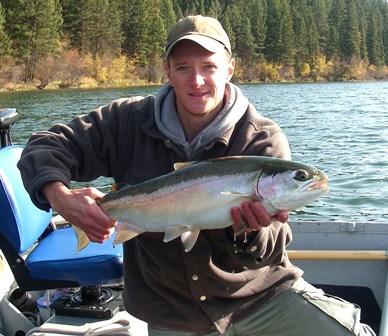 Those fish were a foot off bottom and I know they were real because I was catching them. When 4 guys can line up in a row and everyone is getting fish almost non-stop you know they’re cruising all over the area feeding and those are the times when my fish finder really works well.
Those fish were a foot off bottom and I know they were real because I was catching them. When 4 guys can line up in a row and everyone is getting fish almost non-stop you know they’re cruising all over the area feeding and those are the times when my fish finder really works well.
It was a fun game: let the vertical line hang and wait for the naked line to sink, then start an ultra-slow retrieve on the naked line while watching “Fish TV” on the finder. When a fish shows itself under the boat set down the naked line and very gently pick up the vertical one, ever so slowly crawl the little fly up several inches, then slowly allow it to sink again.
Fish on!
*** for more still water fly fishing strategies please hit up & review our still water fly fishing category here!
Like our stuff? Subscribe by ![]() Feed or
Feed or ![]() Email
Email .jpg)



